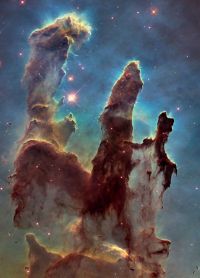Here's Hoping for No More Wasted Space

I love reading stuff like Robert Krulwich’s A Baby Hangs Between Life and Death in Space. He compares images of the famous Hubble “pillars of creation” taken 20 years apart and discusses a difference that appears to show a young star’s progress in being “born.”
The time and distance scales of such discussions are always amazing. After all, we’re talking about distant interstellar objects where traveling 450,000 mph is a walk in the park.
Seeing things like this always make me feel a bit contemplative. First, we puny humans have the will, the technology, and the resources to capture images like these. Second, we are able to rationally and logically speculate about how such objects and events behave based on an understanding of natural laws that we’ve developed over the short time we as humans have lived here on earth. Read Krulwich’s discussion of the role of magnetism, for example. Then, think about what it has taken to get us to the point of rationally speculating on the explanation for one of the interesting phenomena revealed by these images.
Inevitably images and discussions of images like these lead me to wonder about the “are we alone in the universe” question.
Personally, I don’t think we are alone. My “reasoning,” though, is really just a gut feeling akin to Dr. Arroway’s dad saying, “The universe is a pretty big place. If it is just us, seems like an awful waste of space.”
But that’s just a feeling, like a matter of faith. It’s not hard evidence that can be processed by the evolved human brain.
Here’s hoping that, someday soon, a researcher going over images like the ones discussed in Krulwich’s article will give something second look and exclaim, “Hey, that’s not a natural phenomenon!”
Related reading
Bob Berman’s THE SUN’S HEARTBEAT: And Other Stories from the Life of the Star That Powers Our Planet
Ed Regis’ WHAT IS LIFE: INVESTIGATING THE NATURE OF LIFE IN THE AGE OF SYNTHETIC BIOLOGY
Len Fisher’s WEIGHING THE SOUL: THE EVOLUTION OF SCIENTIFIC BELIEFS
Lisa Jardine’s INGENIOUS PURSUITS: BUILDING THE SCIENTIFIC REVOLUTION
Richard Corfield’s LIVES OF THE PLANETS: A NATURAL HISTORY OF THE SOLAR SYSTEM
Copyright © 2015 by Dennis D. McDonald




